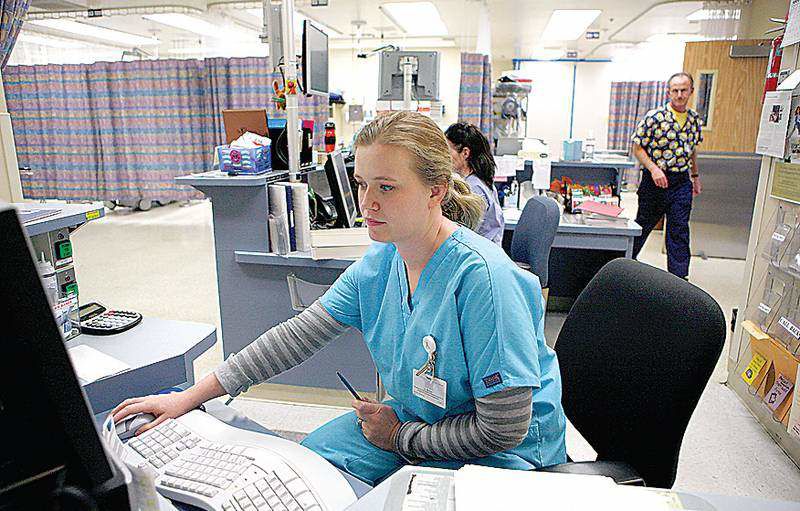St. Charles Redmond’s ER expands
Published 4:00 am Wednesday, January 16, 2008

- Jennifer Hendricks, of Redmond, works Tuesday in admitting at the ER at St. Charles Redmond.
St. Charles Redmond’s emergency room is getting an operation of its own — more space and more beds, and with that, more privacy for patients.
Hospital administrators say the change — which will nearly double the ER’s square footage, to 4,680 square feet, and more than double its beds, to 14 — is long overdue for a department that, physically, hasn’t kept pace with Redmond’s population explosion. The city has tripled in size since the hospital was built 26 years ago and the ER has stayed about the same size, according to hospital officials.
Trending
“We have known for 10 years that the Emergency Department was undersized,” said Jim Diegel, president and CEO of Cascade Healthcare Community Inc., parent company of St. Charles Redmond and St. Charles Bend.
“We have patients on a regular basis waiting in the waiting room, and we have to open other sections of the hospital to expedite patient care. It’s gotten to the point where we can’t wait any longer.”
The new ER will expand into the hospital’s former operating rooms. That space became available when the Jeld-Wen Tower opened in fall 2006 with four new operating rooms. The tower also created 48 private patient rooms.
The ER will be expanded in two phases. The first phase started two weeks ago after more than a year of planning and should be done by the end of March or early April. It will take the ER from six beds to eight, said Beth Reynolds, Emergency Department manager.
The second phase, which should be complete by early summer, will add six more beds, Reynolds said.
Patients needing care won’t have to wait as long or hear sounds of patients receiving care, she said. The new ER will feature private patient rooms. Currently, ER beds are separated by curtains.
Trending
“Patients will have more privacy,” Reynolds said. “Currently, when you’re in the department, you know what’s happening around you. It can be chaotic. Our patient satisfaction scores have been satisfactory, but we want to make them better.”
The department had approximately 15,500 emergency room visits in 2007, about 9 percent more than in 2006, and has grown at a similar rate the past several years, Reynolds said.
The new rooms will allow patients, who typically stay in the ER about three hours, to rest more easily and not mind as much if they have to wait, she said.
The expansion also will increase the hospital’s ability to get patients into beds to begin the diagnostic process, said Matthew Eschelbach, an ER doctor and medical director of the Emergency Department at St. Charles Redmond.
“Auditory privacy is not always guaranteed,” Eschelbach said.
“If somebody’s crying or upset or ill, you’re going to hear that. The new design will improve patients’ experience at the hospital.”
The capital expansion project is the last of several at St. Charles Redmond and St. Charles Bend over the past seven years since the two hospitals merged under Cascade Healthcare in 2001, said Diegel, who served as CEO of the hospital formerly known as Central Oregon District Hospital in Redmond from 1994 until 2000.
Cascade Healthcare has spent $128 million in capital expansion projects at the two sites.
The Redmond hospital — which, unlike St. Charles Bend, does not handle deep trauma wounds — is a general service acute care hospital that draws from a population of about 40,000 people, including parts of Powell Butte, Culver, Sisters and Crooked River Ranch, Diegel said.
Cascade Healthcare’s long-term plan includes another tower with more rooms and imaging services, and a new ER within five to 10 years, he said. The new tower would be immediately south of the Jeld-Wen Tower.
Hospital expansion is an important step for business and community growth, said Jerry Andres, CEO at Jeld-Wen Development Inc. in Redmond.
Jeld-Wen, a subsidiary of Klamath Falls-based Jeld-Wen Inc., developed Eagle Crest Resort west of Redmond and Brasada Ranch, an 1,800-acre destination resort community in Powell Butte.
“Every business relies upon public services of the community,” Andres said.
“The hospital is important not only to our company, but to every company in the region. It’s just as important as having great schools, fire and police departments. It’s an absolute necessity.”
Eagle Crest attracts a large percentage of empty nesters and retirees who may utilize the system more than other residents, Andres said.
“Obviously, the facilities have improved and are improving over there,” he said. “For a community our size, we have an excellent hospital. It’s a quality of life issue. I hear a lot of positive comments.”








